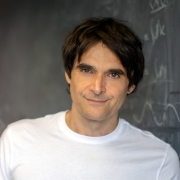A Cosmic Explosion Observed from Philadelphia
Students at the University of Pennsylvania recently captured the explosive end of the life of a star in a nearby galaxy. This supernova was first discovered serendipitously on January 21, 2014, by undergraduate students being trained by Steve Fossey at the University College of London. After waiting out the harsh Philadelphia winter weather and overcoming frigid observing conditions on the roof of the David Rittenhouse Laboratory at 33rd and Walnut, students in the advanced astronomy laboratory course ASTR250 “Astronomical Techniques," taught by Assistant Professor James Aguirre, obtained an image on February 24. By this time, the supernova had passed its maximum brightness, but was still plainly visible, outshining the galaxy in which it exploded (see Figure 1 for the nearly true-color image that was obtained). The ASTR250 course is designed to teach modern astronomical techniques in a hands-on fashion. Although a city like Philadelphia—with its glare of man-made light, and elevation close to sea level placing a thick layer of obscuring atmosphere between us and the stars— is not an ideal place for professional astronomy, these images illustrate the remarkable ability of modern instrumentation. Key to this is the CCD camera, whose inventors won the Nobel Prize in Physics in 2009, which is now ubiquitous in cell phones, laptops, and digital cameras. The ability to work with digital images allows the students to learn powerful, flexible analysis of astronomical data, as illustrated in Figure 2, which shows how the light of the supernova can be separated from that of its host galaxy.
The galaxy in which SN2014J (so called because it is the 10th supernova discovered in 2014) exploded is well-known to amateur and professional astronomers alike. It is a relatively nearby galaxy named Messier 82 (a.k.a. M82, the “Cigar" Galaxy, NGC3034, or Bode's Nebula). SN2014J is of interest to professional astronomers because of its extreme closeness—it is the nearest supernova of its type in 42 years, and the nearest supernova of any type since 2004. Supernovae come in two types: one occurs at the end of the life of star with a mass greater than 8 times that of our sun, but another—of the type of SN2014J—occurs when the “white dwarf" remnant of star of similar mass as our sun acquires additional mass from a companion star, leading to a detonation which completely destroys the white dwarf. These white dwarf supernovae are incredibly useful, because their true luminosity is extremely well understood, and thus, like a light bulb of known wattage, we can use their apparent brightness to figure out how far away they are: nearer ones will appear brighter and further ones fainter. Using these white dwarf supernovae to determine the distances to extremely distant galaxies, together with their velocities away from us, allowed astronomers to work out that the expansion of the universe—known since the mid-1920s—is actually accelerating. This discovery led to the Nobel Prize in Physics in 2011.
Prof. Aguirre will lead a talk about supernovae and their use in determining the accelerating expansion of the universe on Monday, April 7, at 8 p.m. at the Penn-hosted Astronomy Night. Weather permitting, guests will be able to use telescopes set up on Shoemaker Green. Further details can be found here.
Figure 1:

An approximately true-color view of SN2014j in the galaxy M82 as taken on February 24, 2014 by the ASTR250 class at Penn, using the 10 inch diameter telescope on the roof the David Rittenhouse Laboratory. The supernova, appearing yellow, is marked at the location of the cross, and M82 is apparent as the diffuse blue and red glow from upper left to lower right. M82 is thought to be a spiral galaxy, similar in shape to our own Milky Way, but is viewed edge-on by us. It is also 5 times brighter than the Milky Way, and forming stars at several times the rate of the Milky Way. The bright white and blue stars in the image are actually in the Milky Way, between us and M82. The image was made by combining from three camera exposures using red, green, and blue filters separately, and collecting light for approximately 2.5 minutes for each color. This image is sensitive to light 250 times fainter than visible to the unaided human eye.
Figure 2:

A demonstration of the technique of digital subtraction of images. On the left is an image of M82 taken by the ASTR250 class in March 2012 using a blue filter. In the center is an image taken February 24, 2014, with the same telescope and filter, and on the far right is the difference between them. In all three images, the position of SN2014j is marked with the white cross. Because of the high accuracy and repeatability of the telescopes and cameras, and because the stars in the foreground—as well as the light from the M82 galaxy itself—have remained the same in the intervening two years, their contribution to the image largely cancels when the digital image values are subtracted pixel by pixel, leaving just the light from SN2014j. The diffuse glow left over is primarily due to the City of Philadelphia.





